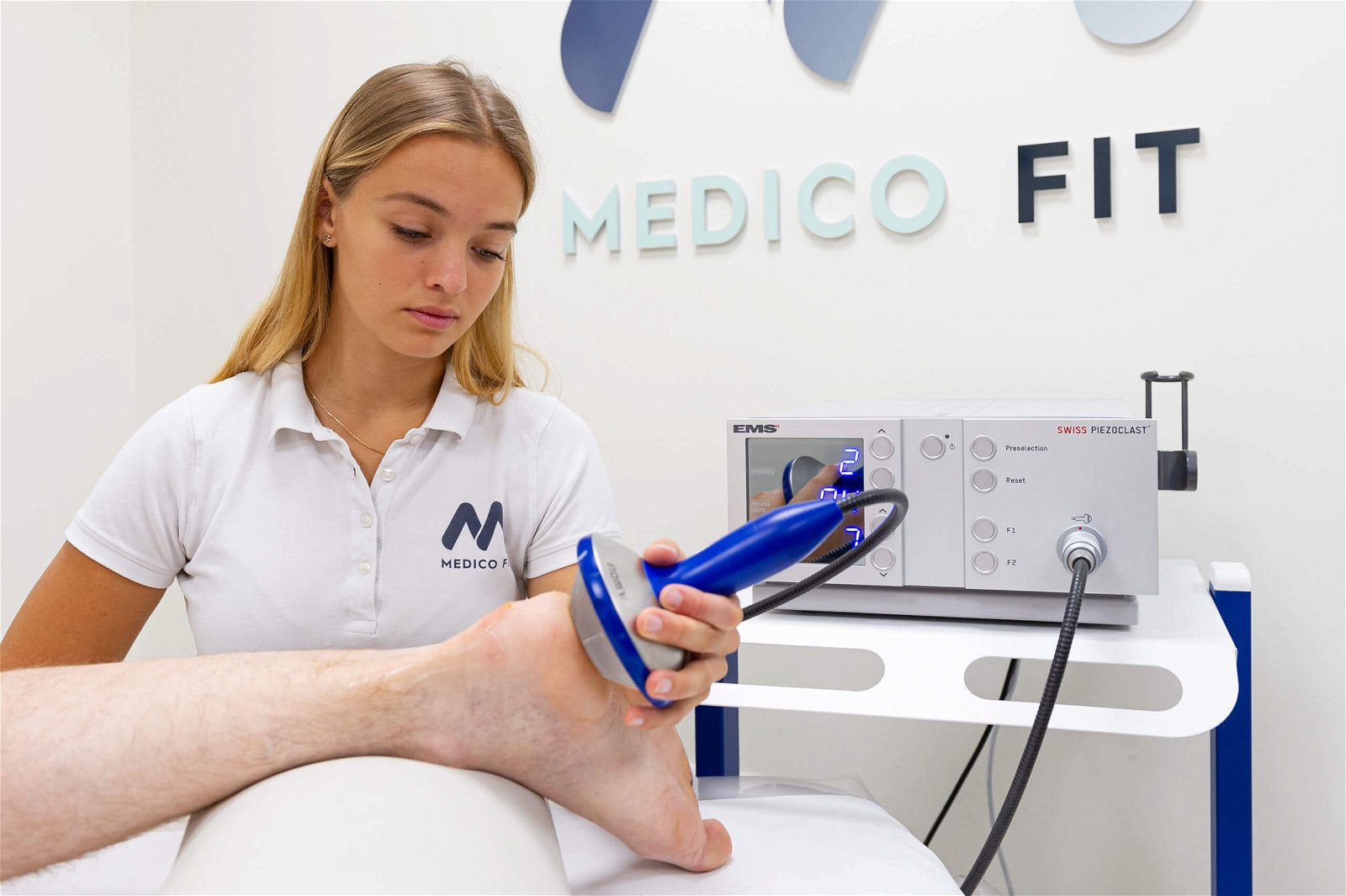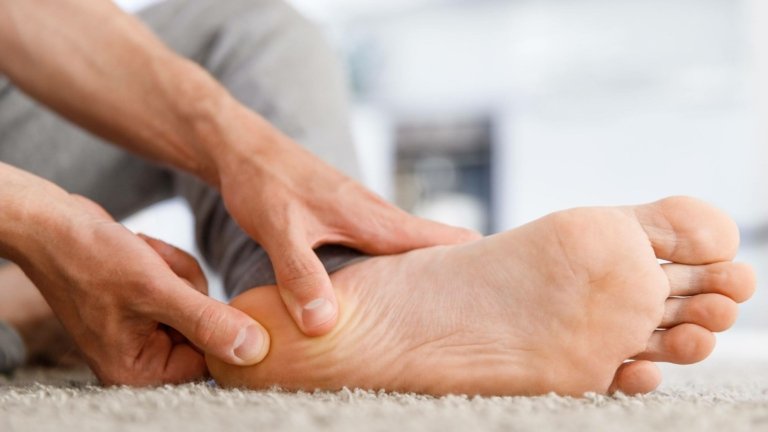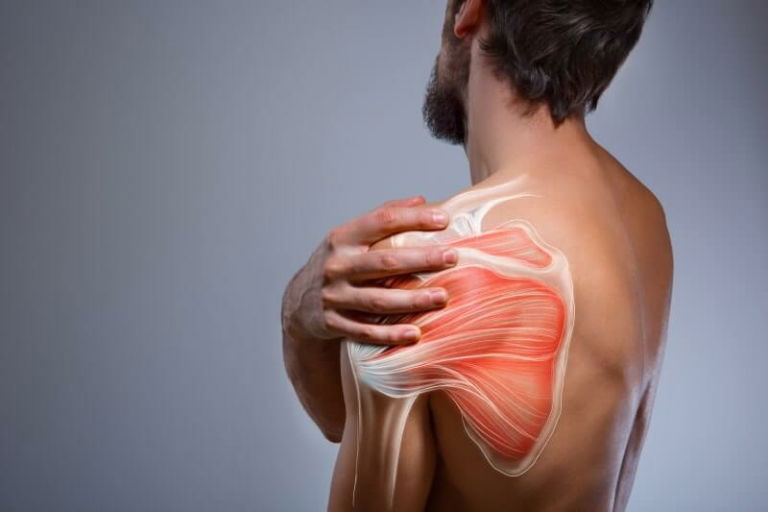-
Bimalleolar fracture
-
Achilles tendon distension injury
-
Calcaneal enthesophytes
-
Achilles tendon enthesopathy
-
Fractura ossis navicularis
-
Haglund’s exostosis
-
Tibiofibular syndesmosis
-
Trimalleolar fracture
-
Vascular hyperplasia of the Achilles tendon
-
Kager’s fat pad inflammation
In a bimalleolar ankle fracture, both the medial malleolus (the inner side of the ankle) and the lateral malleolus (the outer side of the ankle) are injured. Because both sides are injured, the ankle joint becomes unstable.
A bimalleolar fracture disrupts the structural integrity of the ankle joint. Because the joint is unstable, it is susceptible to injury and the development of post-traumatic ankle arthrosis if not treated properly. Surgical repair of the fracture is necessary to properly stabilise the ankle.
Rehabilitation after a bimalleolar fracture is successfully provided as part of the MEDICOFIT specialist physiotherapy for the ankle.
Book a diagnostic therapy appointment for ankle/foot >>
An Achilles tendon distension injury is an injury that occurs due to overstretching or tearing of the tendon that connects the calf muscle to the heel. This type of injury is common in athletes, particularly those who engage in fast-paced or jumping sports such as running, basketball, soccer, and volleyball.
Symptoms of an Achilles tendon distension injury include pain in the heel or back of the shin, swelling, limited mobility, and difficulty walking or standing on the affected leg. A feeling of weakness or tension in the tendon may also occur.
Rehabilitation of an Achilles tendon injury is successfully provided as part of the MEDICOFIT specialist physiotherapy for the ankle.
Book a diagnostic therapy appointment for ankle/foot >>
Enthesophytes are abnormal bone outgrowths at the site of attachment of a tendon or ligament to a bone. It is a common bone response to excessive stress on the attachment site.
A calcaneal enthesophyte is a specific type of ossification of the Achilles tendon that occurs in the heel at the segment where the Achilles tendon attaches to the calcaneus.
Calcaneal bone outgrowths are successfully treated as part of the MEDICOFIT specialist physiotherapy for the ankle.
Book a diagnostic therapy appointment for ankle/foot >>
Achilles tendon enthesopathy is a disorder that affects the attachment site of the Achilles tendon – it usually accompanies tendinopathy. This condition is often the result of overuse or repetitive tendon injuries.
The main symptoms include pain and tenderness at the attachment site of the Achilles tendon, which may worsen when walking, running, or climbing stairs. The pain is often worse in the morning or after a period of rest and can gradually worsen if the condition is left untreated.
Achilles tendon pathologies are successfully treated as part of the MEDICOFIT specialist physiotherapy for the ankle.
Book a diagnostic therapy appointment for ankle/foot >>
Fractura ossis navicularis refers to a fracture of a bone called the navicular bone. The navicular bone is located in the middle of the foot and plays an important role in maintaining the structure of the foot and absorbing loads while walking or running.
A navicular bone fracture can result from direct trauma, such as a fall on the foot or a blow, or it can occur as a result of repetitive loads, such as prolonged running or jumping.
Rehabilitation of a navicular bone fracture is successfully provided as part of the MEDICOFIT specialist physiotherapy for the ankle.
Book a diagnostic therapy appointment for ankle/foot >>
Haglund’s exostosis, also known as Haglund’s deformity, is a condition that affects the heel bone and Achilles tendon. It is a bony outgrowth or protrusion that appears on the back upper part of the heel bone, where the Achilles tendon attaches.
Haglund’s exostosis can cause heel pain, especially when wearing shoes with a tight-fitting back. The pain is often the result of irritation or inflammation of the soft tissues surrounding the area.
Foot deformities are successfully treated as part of the MEDICOFIT specialist physiotherapy for the ankle.
Book a diagnostic therapy appointment for ankle/foot >>
The tibiofibular syndesmosis is the joint connection between the tibia and fibula in the lower leg. It is a connective structure that stabilises and connects these two bones. The syndesmosis is made up of ligaments and fibrous tissue, and is important for maintaining ankle stability and preventing excessive movement between the tibia and fibula.
In the event of an injury to the tibiofibular syndesmosis, ankle stability may be disrupted, which can lead to pain, swelling, poor balance, and difficulty walking.
Syndesmosis injuries are successfully treated as part of the MEDICOFIT specialist physiotherapy for the ankle.
Book a diagnostic therapy appointment for ankle/foot >>
A typical bimalleolar fracture involves injuries to the bones on the inner and outer sides of the ankle. A person with a trimalleolar ankle fracture also has a bone injury on the back of the tibia (posterior malleolar fracture) near the ankle joint.
A trimalleolar fracture is a rarer but very serious type of ankle fracture that requires surgical fixation and extremely long-term rehabilitation with physiotherapy.
Rehabilitation after a trimalleolar fracture is successfully provided as part of the MEDICOFIT specialist physiotherapy for the ankle.
Book a diagnostic therapy appointment for ankle/foot >>
When the Achilles tendon (which has poor blood supply) is injured, the body responds by forming new blood vessels, which could allow for better blood circulation and regeneration.
Unfortunately, the newly formed blood vessels are hyperpermeable – they leak and lack adequate perfusion. These vessels cannot deliver the oxygen and nutrients needed for tissue maintenance and possible regeneration, which leads to additional tendon hypoxia, which further intensifies pain in the area of injury.
Achilles tendon hyperplasia is successfully treated as part of the MEDICOFIT specialist physiotherapy for the ankle.
Book a diagnostic therapy appointment for ankle/foot >>
Inflammation or oedema of the Kager’s fat pad is an inflammation of the fat pad that lies deep under the Achilles tendon. A person with this condition usually experiences heel pain during the first steps they take after getting out of bed, which subsides slightly after a short walk, then recurs with longer walks.
Kager’s fat pad oedema is often seen on MRI scans after an ankle or Achilles tendon injury.
Ankle injuries are successfully treated as part of the MEDICOFIT specialist physiotherapy for the ankle.












